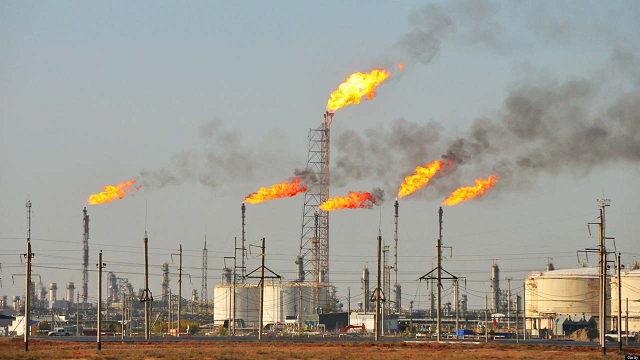To reverse the loss of potential revenue to gas flaring and capital flight due to regular importation of Liquified Natural Gas (LNG) to meet domestic demand, the Nigerian government introduced the Nigerian Gas Flare Commercialization Programme (NGFCP).
The initiative was introduced in 2016 to eliminate gas flaring by capturing it during oil exploration and making the gas available for sale to private firms who will be screened through a transparent bidding process.
The plan was that by 2020, the programme being handled by a team of professionals led by the Project Manager, Justice Derefaka, will bring gas flaring to an end.
However, as of April 2021, the practice which leads to waste of significant volume of gas resources and potential revenue continues despite the existence of a regulation and insufficient local supply of gas to meet demand.
In order to achieve zero gas flaring by 2020, a framework was designed to ensure an open, fair and transparent bidding process by investors who will monetise flare gas, that the investors get the gas at a fair price, improve flare gas monitoring and flare payment enforcement.
The country has missed the 2020 target as this valuable energy resource is wasted and more money is misused on importation of gas to plug gaps in local production. At the same time, Nigeria’s gas-powered electricity plants suffer from gas shortage leading to widespread regular power outage.
READ ALSO: Nigeria Imports 58% Cooking Gas From Equatorial Guinea, Others
Nigeria has been in the practice of setting gas flaring elimination targets and missing them as seen in the target set for 2007, 2008, and 2010.
Why Is Gas Flaring A Problem For Nigeria?
For over 60 years, Nigeria has been battling with gas flaring, which is a common practice during oil extraction when natural gas is burned instead of removing, re-injection or storing for sale.
This natural gas that is allowed to burn in the atmosphere leaves releases excess amount to carbondioxide and methane, causing environmental pollution, affecting health, safety, and quality of life in the environment.
Nigeria successive government administrations have reiterated their commitment to cleaning up the industry and the Nigeria Delta region but despite warnings and deadlines by the Federal Government to oil companies to stop gas flaring, the practice still continues.
Nigeria has the largest proven reserve of gas in Africa and the seventh largest gas flaring nation in the world for nine years running according to a latest report by the World Bank.
However, the report stated that Nigerian has recorded significant progress over the past 15 years as the country has reduced its gas flaring by 70 percent to just 7 billion cubic metres in 2020.
In 2015, data from the Department of Petroleum Resource (DPR) showed that oil and gas companies flared 330.93 million scf of gas equivalent to a potential revenue loss of N243.04 billion.
The following year, the country lost 288.92 million scf of gas to flaring amounting to N229.86 billion. In 2017, over 324.19 million scf of gas was flared equivalent to potential revenue of N267.85 billion while in 2018, 282.08 million scf gas valued at N233.05 billion was burnt off and wasted.
In January and February alone, data obtained from the Nigerian National Petroleum Corporation (NNPC) showed that a total of 26.06 billion standard cubic feet of natural gas was flared in January and February 2021.
This is despite the plans and strategies deployed by the Nigerian government to put an end to the wasteful gas flaring in 2020.
Importing Gas In The Midst Of Abundant Reserves
For some years now, Nigeria has been importing Liquefied Petroleum Gas (LPG), also known as cooking gas for neighboring countries as well as the India and United States in order to meet up with local demand.
According to the data obtained by BizWatch Nigeria from the Petroleum Products Pricing Regulatory Agency (PPPRA)), more than half of the cooking gas consumed in the country in the first three months of the year was imported from Equatorial Guinea and two other countries.
Nigeria, which ranks as the ninth largest natural gas reserve globally, imports cooking gas from Equatorial Guinea, which has only 1.3 trillion cubic feet gas reserves and ranks as the 65th largest globally.
Marketers also imported from the United States and Argentina during the period under review to bridge the production shortfall.
The report showed that marketers imported a total of 170,419.286 metric tonnes from January to March this year.
READ ALSO: OPEC Agrees To Ease Crude Oil Production Cuts From May
While they were only able to produce 123,498.317 metric tonnes of cooking gas during the period under review, representing 42 per cent of total gas consumed during that period.
Meanwhile, the Executive Secretary/Chief Executive Officer, Nigerian Association of Liquefied Petroleum Gas Marketers, Mr Bassey Essien, explained that the majority of the cooking gas produced is exported and reimported.
He said, “Most of the gas we consume is imported, with the associated high costs, based on foreign exchange availability.
“So, when gas is readily available, and supply outstrips demand, then the price will hover at a very comfortable region. But when at every point in time, the demand outstrips supply, the price will go up.
Again, the commodity comes into the country at a high cost. Sometime last year, a 20-metric-tonne truck was sold for N3.6m.
According to him, the commodity has become expensive as the price is N5million and N6million.
Essien called for full domestication of LPG in the country to prevent capital flight through importation of the commodity.
New Target Set For 2025
With the country failing to meet the 2020 target to end gas flaring, Minister of State for Petroleum Resources, Timipre Sylva, says the country is committed to a new target for the elimination of gas flaring.
Speaking at a public hearing on gas flaring at the House of Representatives in Abuja, the minister said the elimination of gas flaring was being taken seriously and would come to an end by 2025.
He noted that Nigeria has significantly reduced gas flaring, adding that initiatives had been deployed to ensure the utilisation of gas that is being flared.
“Today, we have actually reduced gas flaring significantly to a very minimal level of eight per cent. If you all recall, in 2020, the ministry of petroleum started what we call the National Gas Expansion Programme and we declared year 2020 as the year of gas,” Sylva said.
“At the beginning of this year, we also declared year 2021 the beginning of the gas decade. We believe that with all the programmes we have in place, we are on course to achieving complete elimination of gas flaring by 2025.”
The Federal Government has made commitments to the Paris Agreement of the United Nations Framework Convention on Climate Change (UNFCCC) to be part of the global flare-out by 2030.
It remains to be seen if the government would be able to surmount the hurdles and achieve the new target to eliminate flaring by 2025.














